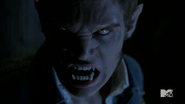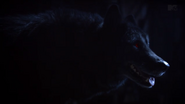Werewolves are a supernatural species of shape-shifter and are the primary protagonists within the Teen Wolf Universe.
Appearance
They usually appear in human form and can shift to varying degrees into a bipedal wolf-like creature with increased body hair, fangs, and glowing eyes.

While most of the werewolves on the show remain in the "nearly human" form; Laura Hale, her mother, Talia Hale could look like a regular wolf when transformed. Derek achieved this "full wolf" transformation at the end of Season 4 but it was only displayed once on screen. Peter Hale took on a monstrous giant wolf-like form indicative of his mental state and lack of control.
The Alpha Twins could merge into one large creature but, while larger than normal, it retained a mostly human appearance.
Become a Werewolf
The bite or deep scratch from an Alpha Werewolf will either kill a person (Paige) or begin the transformation into a werewolf. An Alpha Werewolf bite can also interact with the mental state of the individual to generate different creatures such as Kanima and Werejaguar.

Paw Print
In only one case seen on Teen Wolf, Sebastien Valet in the 1760s became a werewolf after drinking rain water from the paw print of a wolf. It is unclear how this process worked. (See: La Bête du Gévaudan).
Abilities
- Heightened Senses: Werewolves can smell, see and hear far better than humans.
- Accelerated Healing: Werewolves heal quickly from most injuries.
- Enhanced Agility: Werewolves can jump, run, climb and react faster than humans.
- Enhanced Strength: Werewolves are much stronger than humans.
- Pain Transference: Werewolves can absorb and alleviate pain from other people/creatures and can "heal" in some cases.
- Memory Transference: Werewolves can transfer (give or take) memories by inserting claws into the nape of an individual's neck. This ability can establish mind-to-mind communication and, with practice, allow for memory manipulation or erasure.
NOTE: The above abilities are common to all three types of werewolves. Even in human form they appear to possess all of these abilities although there is evidence that the abilities are not always active and must be "turned on" to work. Healing, for instance, can be delayed by choice as long as the werewolf is conscious.
Unique Abilities
- Some werewolves have shown the ability to sense illness and, in one case, the onset of an epileptic seizure. This seems to be due to a combination of their "Heightened Senses" working in concert on a subconscious level.
- Some werewolves have so much mastery over their body that they can inhibit their scent. Making them undetectable to other werewolves.
Perks and Quirks
- Becoming a werewolf can heal scars and cure chronic illnesses like asthma, epilepsy or even cancer.
- Camera flashes and some video recording devices cause werewolves eyes to glow making them nearly impossible to photograph. They can apparently learn to control this effect.
- In the dark, werewolf eyes seem to react to light like a regular canine with eyeshine. This is first seen in The Tell.
- Werewolves cannot become intoxicated by drinking alcohol. It is believed this is due to their enhanced healing ability.
- Smelling chemosignals allows werewolves to know what someone is feeling.
- Werewolves can control their healing ability to some degree, while they are conscious.
- Werewolves, like other shapeshifers, are at the mercy of the full moon and can lose control of their temperament. However the different full moons can have different effects on werewolves.
- During the "Wolf Moon," families/packs get together for a "right of passage." (Teen Wolf: Search for a Cure)
- During the "Worm Moon," a werewolf can be brought back to life with wolfsbane and blood from an Alpha if the body is still intact. However, the werewolf will be physically weak for some time as shown with Peter Hale. (Party Guessed)
- The Supermoon, or perigee syzygy, effects werewolves heavily has the normal full moon activity is amplified and self-control is harder to maintain. The Dread Doctors use the moon to awaken a resurrected La Bête du Gévaudan in Mason Hewitt. (Status Asthmaticus)
Aging
While not defined on the show, it is apparent that some werewolves have a somewhat altered aging process. Creator Jeff Davis explains that the writers, "always thought that werewolves would age more slowly if you are a born werewolf. They also learn more control of their bodies.” This seems to confirm that the lack of visible aging is linked to the mastery of their bodies mentioned in the "Unique Abilities" section above.
Examples -
- In Mexico, during the Dark Moon, Derek was somehow regressed physically from an adult to a teenager.
- Satomi Ito looks the same now as she did in the World War II era episode The Fox and the Wolf.
Weaknesses
Major Weaknesses
Wolfsbane
- The effects of Wolfsbane vary depending on the type, amount and delivery method. It can cause hallucinations, weaken, render unconscious or kill werewolves.
Mountain Ash
- When used properly, Mountain Ash can form an impenetrable barrier to keep supernatural creatures in or out. It can also, according to Dr. Deaton, modify their behavior - keeping them from “causing trouble”.

- Scott describes being surrounded by Mountain Ash at Eichen House as "like being sedated."
Lunar Eclipse
- Werewolves are powerless during a total lunar eclipse.
Mistletoe
- Much like with humans, Mistletoe poisons werewolves and can lead to death if untreated.
Minor Weaknesses
- Inexperienced werewolves are at the mercy of the full moon. Under its sway, they lose control and their homicidal tendencies increase. This can be controlled by force of will, but bitten werewolves have a more difficult time with remaining in control.
- Hecatolite can block the effects of the moon and disrupt the natural cycle of transformation.
- Bites, scratches and other wounds inflicted by an Alpha will not heal as quickly as other injuries.
- Intense pain or steady application of low amperage electricity can keep werewolves weak and in human form.
- While their healing abilities come through in the most dire situations, werewolves can still bleed out with a wound is not properly treated (Unleashed) and any head injury such as being bludgeoned (The Girl Who Knew Too Much) or shot in the head can kill them (The Wolves of War).
EDITOR'S NOTE: The weaknesses mentioned here are unique to werewolves. Other methods of death such as being cut in half or having one's skull crushed would also be fatal to humans and are therefore not specific "werewolf weaknesses". Fire is also mentioned often by fans as a "special weakness" for werewolves but, according to what we've seen on the show, fire harms werewolves significantly less than it does humans. For werewolves, even the worst burns will eventually heal.
Types of Werewolves
There are three known types of werewolves in the Teen Wolf mythology.
Omega
An Omega is the “lone wolf”; existing without a pack and an Alpha. They have all the werewolf abilities mentioned above but are considered weaker than other types because they are not part of a pack. Werewolves can become Omegas by choice or be forced out of a pack by the Alpha or by circumstance. NOTE: The term "omega of the pack" has been used in reference to the lowest ranking member/members of a pack. This does not indicate a drop in actual werewolf status but is instead used as an insult.
Beta
Betas are members of a pack and, because of this association, they are considered stronger than Omegas. They do not seem to have any special abilities beyond those mentioned above.

NOTE: Both Betas and Omegas will show various skill levels based on experience, therefore, a direct comparison of power levels is difficult.
Alpha
An Alpha is the leader of a pack of werewolves. It is the strongest, most powerful and so far the most lethal variety of Werewolf.
Becoming an Alpha
- A Beta or Omega can become an Alpha by killing an Alpha.
True Alpha
A Beta or Omega can become an Alpha through strength of character or force of will alone. These are called “True Alphas” and are very rare.
A True Alpha's status can only be taken by a Beta of their own making.

Special Abilities
- An Alpha’s bite can transform a human into a werewolf. The bite usually only has two outcomes - transformation or death although there are exceptions (See Lydia Martin and Kanima).

- It appears a scratch from an Alpha, if it goes deep enough, can sometimes be transformative. (See Kate Argent).
- Alphas seem to have a limited form of mental control over the betas that they create.
- The Alpha roar is shown to effect other Shapeshifters (See Werecoyote) and even humans.
- Bites, scratches and other wounds inflicted by an Alpha will not heal as quickly as other injuries.
- Alphas can heal the extremely ill with their pain transference ability but they give up part of the "spark" that makes them an Alpha. This can result in a loss of Alpha status.
- Alphas can, by killing their betas, become stronger. (See Alpha Pack)
Beast of Gevaudan
The Beast of Gevaudan is unlike any other werewolf seen on the show. It is larger than even Peter Hale's monstrous form from Season 1 and, instead of shapeshifting, the Beast creates a body composed of what appears to be black smoke or shadows around itself.

Canonically, these differences stem from two sources -
- Sebastien Valet became a werewolf after drinking rainwater from the paw print of a wolf. While this piece of werewolf lore has been mentioned on the show before, this is the only example of it working.
- According to Teen Wolf Creator Jeff Davis, his form and transformation come from how evil he already was when he became a werewolf.
The beast, like Peter Hale in Season 1, was insane and out of control. Werewolves who lose all control are shown to be very strong.
Evolved Werewolf
Regarded as a rare occurrence, some werewolves obtain the ability to shift into an actual wolf.
- Jeff Davis regarded these werewolves as those who have achieved a balance between their wolf nature and their humanity that keep them from becoming beasts.
- This form is only seen with Laura Hale, Talia Hale, and Derek Hale.
- When a werewolf shifts into this form, they revert to human form without their clothes intact.
- Derek achieved this form when he died and came back to life when it seemed he was losing his powers.
- His strength was increased as he was able to break a Berserker mask with ease.
Eye Color
- An Alpha's eyes glow red.
- Yellow is the most common eye color among Betas and Omegas.
- Some Betas and Omegas have blue eyes. This color difference is an indication that they have taken an innocent life. Jeff Davis says the root cause of this change comes from within the werewolf (or werecoyote). "It’s a darkening of the heart. Think of it more as spiritual.”

Packs
Werewolves are social creatures and mostly operate within packs.
Main Article: Teen Wolf Pack
Known Werewolves
- Peter Hale, born werewolf (Former Alpha)
- Scott McCall, bitten by Peter (True Alpha)
- Jackson Whittemore, bitten by Derek (Omega)
- Isaac Lahey, bitten by Derek (Beta)
- Cora Hale (Beta)
- Ethan (Omega)
- Kincaid (Unknown)
- Liam Dunbar, bitten by Scott (Beta)
- Hayden Romero, bitten by Scott (Beta)
- Garrett Douglas, (Alpha Werewolf/Löwenmensch turned Ghost Rider)
- Mrs. Finch (Alpha)
- Alec (Beta)
- Eli Hale (Beta)
Deceased Werewolves
- Laura Hale, born werewolf (Alpha)
- Erica, bitten by Derek (Beta)
- Boyd, bitten by Derek (Beta)
- Kali (Alpha)
- Ennis (Alpha)
- Aiden (Omega)
- Talia Hale (Alpha)
- Sebastien Valet, Beast of Gevaudan (Unclassified)
- Brett Talbot, born werewolf (Beta)
- Lori Rohr, born werewolf (Beta)
- Jiang (Beta)
- Tierney (Beta)
- Satomi Ito, bitten werewolf (Alpha)
- Quinn (Beta)
- Deucalion (Alpha)
- Derek Hale, born werewolf (Evolved)





























